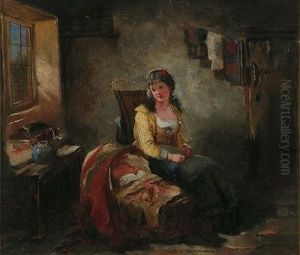William C. Faed Paintings
William C. Faed, born in 1822 in Barlay Mill, Gatehouse of Fleet, Kirkcudbrightshire, Scotland, was a distinguished 19th-century Scottish painter known for his genre and historical scenes. Coming from a family deeply rooted in the arts, his siblings John and Thomas, also gained recognition in the art world, making the Faeds a significant name in the Scottish art scene of the time. William's artistic journey began under the guidance of his father, who was a millwright and amateur artist, instilling in him an early appreciation for art and craftsmanship.
After his initial education in Scotland, Faed's ambition and talent led him to further his studies at the Trustees’ Academy in Edinburgh, where he was exposed to the vibrant artistic community of the time and received formal training. This period was crucial in developing his style and in establishing connections that would support his future career. His works often depicted scenes of Scottish life, history, and literature, resonating with the Victorian audience's fascination with narratives and moral lessons. Faed's ability to capture emotion and detail in his paintings earned him critical acclaim and a loyal following.
Throughout his career, William C. Faed exhibited extensively, including at prestigious institutions such as the Royal Scottish Academy, where he became a full member, and the Royal Academy in London. His artworks were celebrated for their technical skill, storytelling, and emotional depth, which spoke to the social and historical consciousness of his time. Despite the changing tastes in art with the advent of modernism, Faed's works remained influential examples of 19th-century genre painting. He passed away in 1909, leaving behind a legacy appreciated by historians and collectors alike. His paintings continue to be studied and admired for their insight into Victorian society and their artistic merit.

